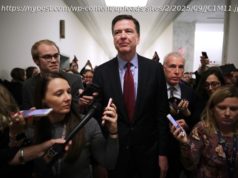Puerto Ricans came together to count their losses and reflect on life after Hurricane Maria.
YABUCOA, P. R. — The morning on Thursday was quieter than it was a year ago in this small farming town on the southeast coast of Puerto Rico.
The sound of waves crashing against the cliffs filled the air. The distinctive mating call of coquís, the native mountain frogs of the island, whistled in the trees as the sun rose and fused the Caribbean horizon with hues of orange and purple.
Then, at 6:15 a.m., a sonorous voice rose above the morning hum:
“I am the light of the morning
that shines new paths,
that floods the mountains,
and the peasant trails…”
The singer, Alberto Carrión, intoned Spanish verses from a seaside cliff at exactly the same time and in the same town where Hurricane Maria made landfall in Puerto Rico a year ago, on Sept. 20. Instead of the howling winds of last year, Puerto Ricans woke to the heartening lyrics of “Amanecer borincano” — “Puerto Rican Sunrise” — in a performance that was televised and live-streamed across the island to commemorate the anniversary.
[ A year after Hurricane Maria, read how thousands of homes are still in ruins .]
“It talks about a new sunrise in Puerto Rico and about having hope,” said Mr. Carrión, a popular Puerto Rican songwriter who was joined by a choir of students from the University of Puerto Rico. “Maria hit us hard, but we’re even stronger and we’ll overcome this.”
The oceanside tribute was the beginning of an emotional day for Puerto Ricans a year after the most destructive hurricane in generations threw the island into months of calamity, destroying most of the power grid, sweeping away thousands of homes and claiming the lives of about 3,000 people .
It was an especially teary-eyed day in Yabucoa, whose 30,000 residents were the first to feel the fury of Hurricane Maria. Many households here were without power for 10 months. And blue roof tarps are still a common sight in the mountain and coastal neighborhoods.
In a rural town deep in recovery, the anniversary surfaced the emotional scars many residents still bear as they spent the day reliving the storm, counting their losses and reflecting on life after Maria.
For Darlene Rivera, 43, that meant remembering her mother, Astrid Roldán, who died almost three months after the storm. Ms. Roldán was 70 and had diabetes, and struggled to keep her insulin cool after losing power. The public housing complex where she lived did not allow residents to have a generator in their apartments, Ms. Rivera said.
“The desperation those days, without electricity, without water, without communication, deteriorated her health over months and it led to her heart attack,” Ms. Rivera said.
Ms. Rivera said that President Trump’s remarks denying the official death toll on the island were especially hurtful and lacked “human sensibility,” especially in light of her mother’s fate.
“There is no reason for my mother not to be here today,” she said.
For Carmen Cruz and her husband, it has been a long 12 months since Hurricane Maria’s galloping 155-mile-an-hour winds blew away the couple’s wooden home in a matter of hours.
“It was a little house, two bedrooms,” said Ms. Cruz, 54, breaking into tears. “But for me it was a castle.”
The couple and their two daughters slept in cots at a neighbor’s house for three months after the hurricane before moving into the home of a deceased family member. The family is still wrangling with the federal government over money to rebuild their home. The generosity and the solidarity among neighbors was the only positive remnant of the storm, Ms. Cruz said.
“We need to continue being united,” she said. “Our strength is in our union.”
[ Creativity from the chaos: Hurricane Maria and the arts .]
Volunteers from the mainland who have spent months in Yabucoa helping residents rebuild their homes echoed similar sentiments.
“Resilience and grace from people — that’s what I’ve found here,” said L. B. Cook, who traveled from Mississippi as a coordinator for All Hands and Hearts — Smart Response, a volunteer group.
Ms. Cook, who has been repairing roofs in Yabucoa since January, said volunteers fixed their 200th roof on Thursday. Her team identified another 800 homes that still need repairs.
As principal of the vocational high school in Yabucoa, José Andino was quick to quantify his losses: 100. That’s the number of his students who left Puerto Rico after the hurricane, which ravaged the school’s campus, forcing it to close for two months.
“Every day the school was closed I knew we were losing one student,” Mr. Andino said from his office. “This is a catastrophic event we could have never imagined.”
Mr. Andino, 40, said that about a fourth of the 387 students who stayed had a significant decline in their grades last year — many had lost their homes, some lost family members. The hurricane also damaged seven of the 10 workshop buildings where students study trades, including carpentry, electrical wiring and culinary arts.
“We’re not operating at 100 percent,” Mr. Andino said. “There’s just no way.”






